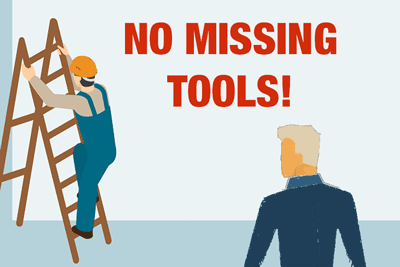In the fast-paced business landscape efficient asset management is crucial for maintaining a competitive edge. Integrating asset management with your inventory system can elevate your operational efficiency to the new heights. A single system for managing assets and inventory helps you streamline workflows, reduce costs, and ensure optimal utilization of resources. Discover how to bridge the gap between asset and inventory management for comprehensive control and improved efficiency.
Optimizing the management of both inventory and assets is paramount if you want to stay ahead of the competition. The ability to track and manage tools, equipment, and other assets, alongside traditional inventory, offers comprehensive control that can significantly boost operational efficiency. For professionals dealing with asset management daily, integrating asset management with inventory systems provides numerous benefits, from better resource allocation to improved maintenance scheduling.
Asset And Inventory Management: Common Points And Differences
Inventory
Inventory encompasses goods or materials held by a company for production, sale, or consumption. Examples include raw materials, work-in-progress items, finished goods, and packaging materials. The primary focus of inventory management is optimizing stock levels to meet demand while minimizing holding costs and stockouts.Assets
Assets are valuable items owned by a company that contribute to its overall worth and operations. Examples include machinery, tools, vehicles, computers, and furniture. Asset management centers on tracking, maintenance, and maximizing the value and utilization of assets throughout their lifecycle.Common Points And Differences
| Common Points | Differences | |
| Tracking | Both asset and inventory management involve tracking items through their lifecycle. | Inventory focuses on the shorter lifecycle of goods intended for sale or consumption, while asset tracking monitors fixed assets over their longer lifespans, including assignment, utilization, maintenance, and repairs. |
| Resource Optimization | Both asset and inventory management aim to optimize resources for maximum efficiency and value. | Asset optimization focuses on maximizing utilization and lifespan through maintenance and allocation, while inventory optimization emphasizes efficient flow and minimal holding costs to meet demand. |
| Data Collection & Management | Both assets and inventory management rely on the accurate data collection and analysis to make informed decisions. This includes tracking item location, condition, usage, and costs. | Asset data management focuses on long-term tracking of condition, maintenance, and depreciation, while inventory data management prioritizes real-time tracking of quantities, location, and sales for efficient replenishment. |
| Financial Impact: | Both assets and inventory directly affect a company's financial health. Mismanaged assets or inventory can lead to increased costs, lost revenue, and decreased profitability. | Poor asset management leads to increased maintenance costs, reduced asset lifespans, and potential for unexpected breakdowns, while poor inventory management results in excess carrying costs, stockouts, and lost sales opportunities. |
Technology plays a crucial role in both asset and inventory management, enabling real-time tracking, data analysis, and automation of various processes. Integrating asset and inventory management within a single system offers numerous benefits, such as improved visibility, streamlined workflows, enhanced decision-making, and ultimately increased profitability.

Key Benefits of Integrating Asset Management with Inventory Systems
1. Enhanced Visibility and Tracking In A Single Place
A unified system provides complete visibility over all assets and inventory in real-time through a single software dashboard. The real time assets and inventory visibility allows businesses to:- Monitor Usage Track how and when assets and inventory are used, ensuring that resources are allocated efficiently.
- Prevent Loss and Theft Maintain accurate records to reduce the risk of loss, theft, or misplacement of valuable assets and inventory.
- Streamline Audits Simplify the auditing process with centralized data, making it easier to verify the presence and condition of assets and inventory.
2. Better Resource Allocation
By integrating asset and inventory management, businesses can optimize resource allocation. This leads to:- Reduced Downtime Ensure that the right tools and equipment are available when needed, minimizing downtime and delays.
- Improved Utilization Maximize the use of assets by tracking their availability and scheduling their use efficiently.
- Cost Savings Avoid over-purchasing or under-utilizing assets, leading to significant cost savings.
3. Efficient Equipment Maintenance
Proper maintenance is essential for prolonging the lifespan of assets and ensuring their optimal performance. An integrated system helps scheduling and tracking asset maintenance, along with the parts and materials that are required and used.- Automated Reminders Set up automated maintenance reminders for equipment, as well as low stock alerts on parts and materials that you need for timely maintenance.
- Maintenance Records Keep detailed records of all maintenance activities, as well as parts and materials usage for different equipment. The combined system helps you identify patterns and predict future maintenance needs.
- Reduced Downtime Ensure that equipment is well maintained, and you always have spare parts on hand.
4. Data-Driven Decision Making
Combining asset and inventory data provides valuable insights that can drive better decision-making:- Forecasting Analyze usage patterns to forecast future needs and make informed purchasing decisions for both inventory and equipment.
- Billing And Budgeting Track costs associated with assets and inventory to manage budgets and customer billing for th jobs more effectively.
- Performance Analysis Evaluate the performance of assets and inventory side by side, identifying areas for improvement.
5. Regulatory Compliance
Many industries have strict regulations regarding asset management. An integrated asset and inventory management system helps ensure compliance by:- Accurate Reporting Maintain accurate and up-to-date traceability records, that include both product batch tracking and asset / equipment that was used in the process.
- Audit Trails Provide comprehensive audit trails required for compliance with industry standards and regulations.
- Risk Management Identify and mitigate risks associated with asset management and inventory control.

How Our Solution Can Help
QR Inventory is a state-of-the-art inventory and asset management system designed to provide comprehensive control over your business operations. Our cloud-based solution integrates seamlessly with the mobile devices, enabling real-time tracking and management of all your assets and inventory.Some of the features of QR Inventory that will help you take inventory and assets under control are:
- Real-Time Visibility Monitor all assets and inventory in real-time from any device.
- Scalability Scale our solution to meet the growing needs of your business.
- User-Friendly Interface Enjoy an intuitive and easy-to-use interface that requires minimal training.
- Granular User Privileges Multiple user roles that can be configured in such a manner that users can perform their duty seamlessly and securely.
- Integrations Integration with accounting systems (such as QuickBooks) and project management systems (such as Procore and Asana).
Conclusion
Integrating asset management with inventory systems is a strategic move that can significantly enhance your business operations. By improving visibility, optimizing resource allocation, ensuring efficient maintenance, and enabling data-driven decision-making, a unified system provides comprehensive control that can drive your business success.Ready to take control of your assets and inventory? Contact us to learn more about our innovative solutions and how we can help your business achieve its full potential.
We are located in beautiful Boise, Idaho. It’s Mountain Time Zone.
